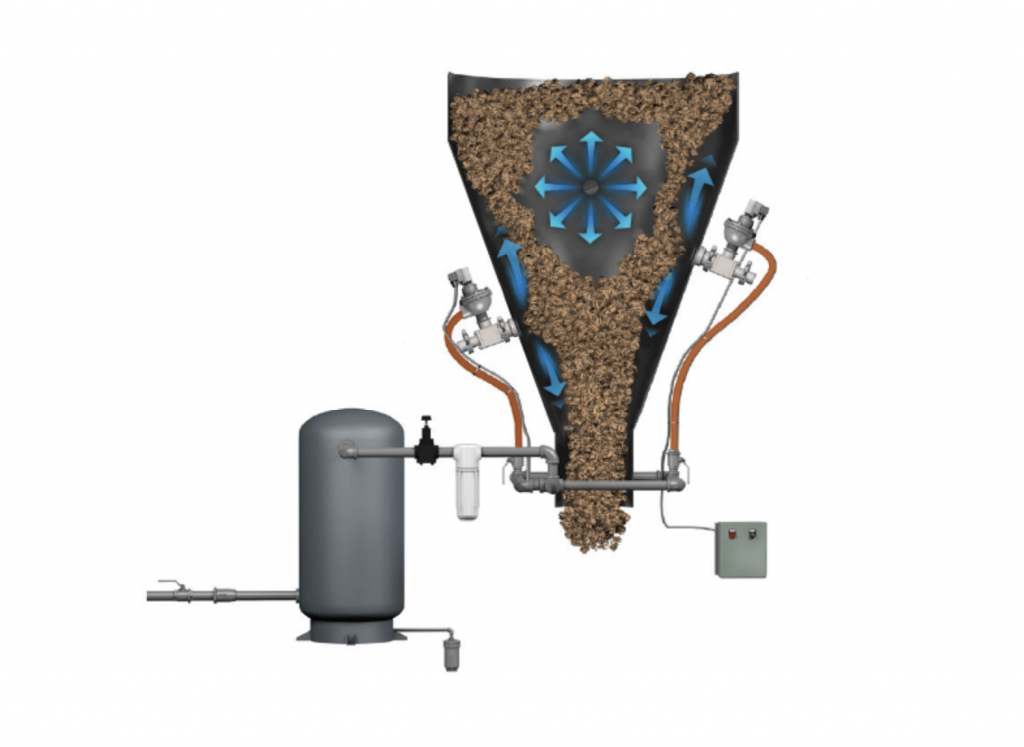
In all industries, the efficient movement and storage of materials play a vital role in smooth operations and increased productivity. If the material flow stops, so does production—and every delay incurs costs and risks.
This is where bulk material handling comes into play. This field of engineering looks at the fundamental principles of managing tons of material, and the best strategies for achieving reliable material flow.
In this blog post, we will look at what is bulk material handling, its key components, and various methods used in different industries and applications.
What is Bulk Material Handling?
Bulk material handling is the process of moving, storing, and managing large quantities of dry or granular materials. These are in their loose or bulk state, rather than packaged goods. Examples include powders, grains, minerals, chemicals, and aggregates.
It encompasses various stages:
- Unloading: Materials are removed from trucks, railcars, or other transportation vessels
- Conveying: Materials are transported from one location to another through a network of belts, pipes, or other systems
- Storing: Materials are stored in bins, silos, or warehouses for easy access and inventory management
- Blending: Materials are mixed together in precise proportions to create desired product formulations
- Loading: The final product is transferred to trucks, railcars, or other means of transportation for distribution to customers or further processing.
What is Bulk Material Handling Efficiency?
The goal of bulk material handling is to effectively manage the movement and flow of bulk materials throughout the handling process.
Efficiency in bulk material handling encompasses various aspects, including:
- Smooth Material Flow: Materials flow smoothly and continuously from one stage to another without interruptions, blockages, or slowdowns. This is achieved by using the right equipment, designing the right material flow paths, and applying the right strategies to prevent material blocks.
- Minimized Downtime: Efficient material handling minimizes the time required for maintaining equipment, clearing blocks, or resolving material flow problems.
- Optimal Equipment Utilization: Equipment should operate at full capacity and potential. It’s important to use the right equipment for the specific application and maintain it properly to avoid bottlenecks and idle time.
- Cost Reduction: Efficient bulk material handling can help lower costs by preventing material waste and lowering energy consumption. And if material flows efficiently, this usually allows for better inventory management.
- Safety Enhancement: Any bulk material handling process must include safety protocols and proper training to lower the risk of accidents or incidents caused by poor material flow or equipment failure.
- Data Monitoring and Analysis: Bulk material handling efficiency identifies stages in the process that can be improved or optimized. It is useful to monitor and analyze data like flow rates and equipment performance, then use these insights to make informed decisions.
What are the best practices for bulk material handling?
Every company will have unique bulk material handling challenges, based on the materials and processes they use.
While there is no “cookie cutter” approach to perfect material flow, these practices can help prevent the most common problems.
- Do regular equipment inspections: Inspect silos, hoppers, conveyor belts, and other equipment to identify and correct any issues before they become bigger and more expensive to fix.
- Follow preventative maintenance: Cleaning, lubricating, and replacing worn-out components can keep equipment at optimum performance, and prevent blocks caused by mechanical failures or inefficiencies.
- Know the material’s characteristics: Carefully consider the characteristics of bulk materials and use the appropriate equipment and handling techniques. For example, use filters to remove impurities that can cause blockages, or optimize material flow rates to prevent overfilling storage bins.
- Use the right flow aid: Flow-aid systems such as AirSweep promote consistent material flow and prevent blockages.
Improve Bulk Material Handling Efficiency with AirSweep
AirSweep is a highly effective bulk material handling system that promotes smooth, on-demand material flow.
It uses strategically placed nozzles that release powerful air pulses that disperse and dislodge materials without requiring mechanical force.

Unlike traditional methods that need manual intervention or costly equipment modifications, AirSweep offers a simple yet robust solution.
- Efficient material flow: AirSweep ensures consistent and unrestricted material flow by breaking up bridging, ratholing, and other material blocks. This leads to improved productivity, reduced downtime, and increased overall efficiency.
- Higher savings: By preventing blockages and material buildup, AirSweep reduces the need for manual labor, equipment downtime, and maintenance costs. Unlike vibrators and air cannons, it does not cause metal fatigue—thus reducing maintenance and replacement expenses.
- Versatility: AirSweep systems can be installed on hoppers, silos, chutes, bins, conveyors—or any equipment where material can pile up. It has been used in practically every industry, including cement, food processing, mining, power generation, and more.
- Easier installation and maintenance: AirSweep can be installed with simple tools and can be retrofitted into existing equipment with ease. It also has low maintenance requirements, ensuring uninterrupted operations and saving time for maintenance personnel.
- Fewer safety risks: AirSweep helps prevent material buildup, which can lead to hazardous conditions such as collapsed bridging, fires, and explosions.
Improve your material handling efficiency today
Whether you are dealing with powders, grains, or other bulk materials, consider AirSweep as part of your material handling strategy. Contact us to learn more about what we can do for your process.





Comments are closed